
Illustrative Math Alignment: Grade 6 Unit 9
Putting it All Together
Lesson 4: How Do We Choose?
Use the following Media4Math resources with this Illustrative Math lesson.
| Thumbnail Image | Title | Body | Curriculum Topics |
|---|---|---|---|

|
Video Definition 47--Rationals and Radicals--Zero of a Rational Function | Video Definition 47--Rationals and Radicals--Zero of a Rational Function
TopicRationals and Radicals DescriptionThe Zero of a Rational Function is the value of the input variable for which the rational function equals zero. For example, in f(x) = (x - 1)/(x + 1), the zero occurs at x = 1. This term highlights the connection between the numerator of a rational function and its roots, which are essential for solving equations involving rational expressions. |
Rational Functions and Equations |
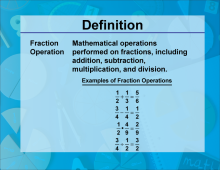
|
Video Definition 14--Fraction Concepts--Fraction Operation | Video Definition 14--Fraction Concepts--Fraction Operation
TopicFractions DescriptionFraction operations include addition, subtraction, multiplication, and division. Examples include 1/2 + 1/3 = 5/6, 3/4 - 1/4 = 1/2. These operations require finding a common denominator for addition/subtraction or applying direct multiplication/division for the respective operations. This encapsulates the arithmetic procedures involving fractions, forming the basis for more complex problem-solving. |
Fractions and Mixed Numbers |

|
Video Definition 20--Fraction Concepts--Irrational Number | Video Definition 20--Fraction Concepts--Irrational Number
TopicFractions DescriptionAn irrational number cannot be expressed as a fraction and has a non-terminating, non-repeating decimal form. Examples include π = 3.14159... and √2 = 1.41421.... This highlights the contrast between rational and irrational numbers. This connects fractions to the broader number system, emphasizing differences in numerical properties. |
Fractions and Mixed Numbers |
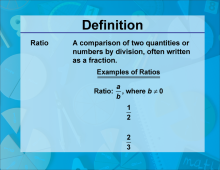
|
Video Definition 32--Fraction Concepts--Ratio | Video Definition 32--Fraction Concepts--Ratio
TopicFractions DescriptionA ratio is a comparison of two quantities or numbers by division, often written as a fraction. The image defines it as a / b, where b ≠ 0, and provides examples like 1 / 2 and 2 / 3. This term bridges fractions and their use in comparing quantities, which helps learners connect fraction concepts to real-world applications such as proportions and rates. |
Fractions and Mixed Numbers |
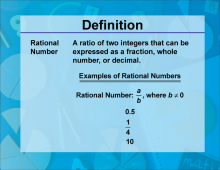
|
Video Definition 33--Fraction Concepts--Rational Number | Video Definition 33--Fraction Concepts--Rational Number
TopicFractions DescriptionA rational number is defined as a ratio of two integers that can be expressed as a fraction, whole number, or decimal. Examples provided in the image include 0.5, 1 / 4, and 10. The term builds on the concept of ratios and fractions by showing that they can also represent rational numbers, broadening the application of fractions to include whole numbers and decimals. |
Fractions and Mixed Numbers |
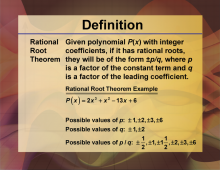
|
Video Definition 32--Polynomial Concepts--Rational Root Theorem (Spanish Audio) | Video Definition 32--Polynomial Concepts--Rational Root Theorem (Spanish Audio)
TopicPolynomials DescriptionRational Root Theorem: For a polynomial P(x) with integer coefficients, if it has rational roots, they will be of the form ±p/q, where p is a factor of the constant term and q is a factor of the leading coefficient. Example: P(x) = 2x3 + x2 - 13x + 6. Introduces a systematic way to identify potential rational roots of a polynomial. |
Factoring Polynomials |

|
Video Definition 32--Polynomial Concepts--Rational Root Theorem | Video Definition 32--Polynomial Concepts--Rational Root Theorem
TopicPolynomials DescriptionRational Root Theorem: For a polynomial P(x) with integer coefficients, if it has rational roots, they will be of the form ±p/q, where p is a factor of the constant term and q is a factor of the leading coefficient. Example: P(x) = 2x3 + x2 - 13x + 6. Introduces a systematic way to identify potential rational roots of a polynomial. |
Factoring Polynomials |
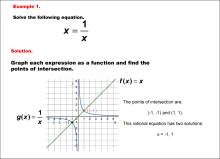
|
Math Example--Graphical Solutions to Rational Equations--Example 1 | This is part of a collection of math examples that show how to use graphical techniques to solve rational equations.
Note: The download is an image file.
Related ResourcesTo see additional resources on this topic, click on the Related Resources tab.Create a Slide ShowSubscribers can use Slide Show Creator to create a slide show from the complete collection of math examples on this topic. To see the complete clip art collection, click on this Link. To learn more about Slide Show Creator, click on this Link:AccessibilityThis resource can also be used with a screen reader. |
Rational Functions and Equations |

|
Math Example--Graphical Solutions to Rational Equations--Example 2 | This is part of a collection of math examples that show how to use graphical techniques to solve rational equations.
Note: The download is an image file.
Related ResourcesTo see additional resources on this topic, click on the Related Resources tab.Create a Slide ShowSubscribers can use Slide Show Creator to create a slide show from the complete collection of math examples on this topic. To see the complete clip art collection, click on this Link. To learn more about Slide Show Creator, click on this Link:AccessibilityThis resource can also be used with a screen reader. |
Rational Functions and Equations |
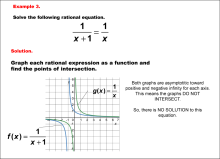
|
Math Example--Graphical Solutions to Rational Equations--Example 3 | This is part of a collection of math examples that show how to use graphical techniques to solve rational equations.
Note: The download is an image file.
Related ResourcesTo see additional resources on this topic, click on the Related Resources tab.Create a Slide ShowSubscribers can use Slide Show Creator to create a slide show from the complete collection of math examples on this topic. To see the complete clip art collection, click on this Link. To learn more about Slide Show Creator, click on this Link:AccessibilityThis resource can also be used with a screen reader. |
Rational Functions and Equations |
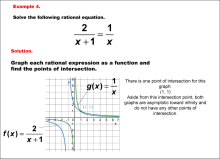
|
Math Example--Graphical Solutions to Rational Equations--Example 4 | This is part of a collection of math examples that show how to use graphical techniques to solve rational equations.
Note: The download is an image file.
Related ResourcesTo see additional resources on this topic, click on the Related Resources tab.Create a Slide ShowSubscribers can use Slide Show Creator to create a slide show from the complete collection of math examples on this topic. To see the complete clip art collection, click on this Link. To learn more about Slide Show Creator, click on this Link:AccessibilityThis resource can also be used with a screen reader. |
Rational Functions and Equations |
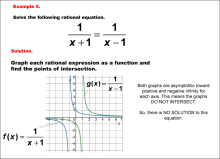
|
Math Example--Graphical Solutions to Rational Equations--Example 5 | This is part of a collection of math examples that show how to use graphical techniques to solve rational equations.
Note: The download is an image file.
Related ResourcesTo see additional resources on this topic, click on the Related Resources tab.Create a Slide ShowSubscribers can use Slide Show Creator to create a slide show from the complete collection of math examples on this topic. To see the complete clip art collection, click on this Link. To learn more about Slide Show Creator, click on this Link:AccessibilityThis resource can also be used with a screen reader. |
Rational Functions and Equations |
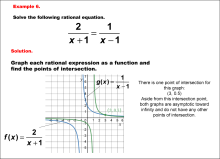
|
Math Example--Graphical Solutions to Rational Equations--Example 6 | This is part of a collection of math examples that show how to use graphical techniques to solve rational equations.
Note: The download is an image file.
Related ResourcesTo see additional resources on this topic, click on the Related Resources tab.Create a Slide ShowSubscribers can use Slide Show Creator to create a slide show from the complete collection of math examples on this topic. To see the complete clip art collection, click on this Link. To learn more about Slide Show Creator, click on this Link:AccessibilityThis resource can also be used with a screen reader. |
Rational Functions and Equations |
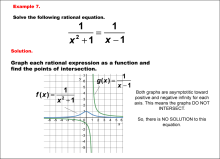
|
Math Example--Graphical Solutions to Rational Equations--Example 7 | This is part of a collection of math examples that show how to use graphical techniques to solve rational equations.
Note: The download is an image file.
Related ResourcesTo see additional resources on this topic, click on the Related Resources tab.Create a Slide ShowSubscribers can use Slide Show Creator to create a slide show from the complete collection of math examples on this topic. To see the complete clip art collection, click on this Link. To learn more about Slide Show Creator, click on this Link:AccessibilityThis resource can also be used with a screen reader. |
Rational Functions and Equations |
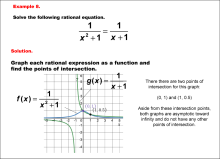
|
Math Example--Graphical Solutions to Rational Equations--Example 8 | This is part of a collection of math examples that show how to use graphical techniques to solve rational equations.
Note: The download is an image file.
Related ResourcesTo see additional resources on this topic, click on the Related Resources tab.Create a Slide ShowSubscribers can use Slide Show Creator to create a slide show from the complete collection of math examples on this topic. To see the complete clip art collection, click on this Link. To learn more about Slide Show Creator, click on this Link:AccessibilityThis resource can also be used with a screen reader. |
Rational Functions and Equations |
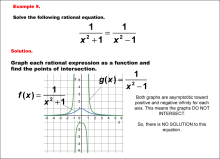
|
Math Example--Graphical Solutions to Rational Equations--Example 9 | This is part of a collection of math examples that show how to use graphical techniques to solve rational equations.
Note: The download is an image file.
Related ResourcesTo see additional resources on this topic, click on the Related Resources tab.Create a Slide ShowSubscribers can use Slide Show Creator to create a slide show from the complete collection of math examples on this topic. To see the complete clip art collection, click on this Link. To learn more about Slide Show Creator, click on this Link:AccessibilityThis resource can also be used with a screen reader. |
Rational Functions and Equations |

|
Math Example--Graphical Solutions to Rational Equations--Example 10 | This is part of a collection of math examples that show how to use graphical techniques to solve rational equations.
Note: The download is an image file.
Related ResourcesTo see additional resources on this topic, click on the Related Resources tab.Create a Slide ShowSubscribers can use Slide Show Creator to create a slide show from the complete collection of math examples on this topic. To see the complete clip art collection, click on this Link. To learn more about Slide Show Creator, click on this Link:AccessibilityThis resource can also be used with a screen reader. |
Rational Functions and Equations |

|
Definition--Vector Concepts--Vector Quantity: Acceleration | Definition--Vector Concepts--Vector Quantity: Acceleration
This is part of a collection of definitions on the topic of Vectors. —Click on PREVIEW to see the definition card.— |
Vectors |
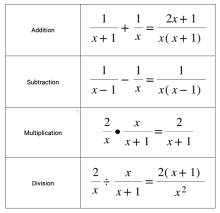
|
Instructional Resource: Tutorial: What Are Rational Expressions? | Instructional Resource: Tutorial: What Are Rational Expressions?
In this tutorial students learn about rational expressions and use the properties of fractions to combine them. —Press PREVIEW to see the tutorial— |
Rational Expressions |
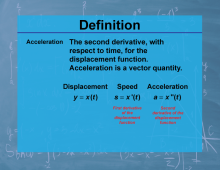
|
Definition--Calculus Topics--Acceleration | Definition--Calculus Topics--AccelerationTopicCalculus DefinitionAcceleration is the rate of change of velocity with respect to time. It is the second derivative of position with respect to time. DescriptionAcceleration is a fundamental concept in calculus, particularly in the study of motion and kinematics. It's crucial for understanding how objects move and change speed over time. In real-world applications, acceleration is used extensively in physics and engineering, from designing roller coasters to launching spacecraft. For example, in automotive engineering, understanding acceleration helps in designing safer vehicles and more efficient engines. |
Calculus Vocabulary |
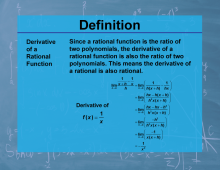
|
Definition--Calculus Topics--Derivative of a Rational Function | Definition--Calculus Topics--Derivative of a Rational FunctionTopicCalculus DefinitionThe derivative of a rational function f(x) = P(x)/Q(x), where P(x) and Q(x) are polynomials and Q(x) ≠ 0, is given by the quotient rule: f'(x) = (Q(x)P'(x) - P(x)Q'(x)) / [Q(x)]2. DescriptionThe derivative of rational functions is a fundamental concept in calculus with significant applications in various fields of science and engineering. It's particularly useful in analyzing rates of change in complex systems, solving differential equations, and optimizing processes in fields like economics, physics, and engineering. |
Calculus Vocabulary |
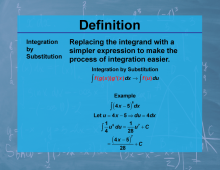
|
Definition--Calculus Topics--Integration by Substitution | Definition--Calculus Topics--Integration by SubstitutionTopicCalculus DefinitionIntegration by substitution is a method used to evaluate integrals by substituting a new variable for a part of the integrand, often simplifying the integral. DescriptionIntegration by substitution is a fundamental technique in calculus, often considered the counterpart to the chain rule for derivatives. It's particularly useful for integrating composite functions and functions involving trigonometric, exponential, or logarithmic terms. This method is widely applied in physics and engineering to solve problems involving changing variables or coordinate systems. |
Calculus Vocabulary |
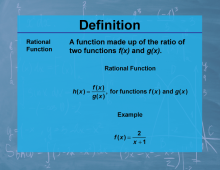
|
Definition--Calculus Topics--Rational Function | Definition--Calculus Topics--Rational FunctionTopicCalculus DefinitionA rational function is a function that can be expressed as the ratio of two polynomials, P(x)/Q(x), where Q(x) ≠ 0. DescriptionRational functions are a crucial class of functions in calculus and algebra, with wide-ranging applications in science, engineering, and economics. They exhibit interesting behaviors such as asymptotes, holes, and discontinuities, making them valuable for modeling complex real-world phenomena. The study of rational functions involves analyzing their domain, range, intercepts, and end behavior. |
Calculus Vocabulary |
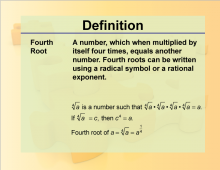
|
Definition--Rationals and Radicals--Fourth Root | Fourth RootTopicRationals and Radicals DefinitionThe fourth root of a number is a value that, when raised to the power of four, gives the original number. DescriptionThe fourth root is an important concept in Radical Numbers, Expressions, Equations, and Functions. It is the inverse operation of raising a number to the power of four. Understanding fourth roots is crucial for solving higher-degree equations and for simplifying radical expressions. Fourth roots are also relevant in various scientific and engineering applications where higher-degree roots are required. They are a part of advanced mathematical studies, including algebra and calculus. |
Radical Expressions |
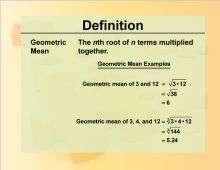
|
Definition--Rationals and Radicals--Geometric Mean | Geometric MeanTopicRationals and Radicals DefinitionThe geometric mean of two numbers is the square root of their product. DescriptionThe geometric mean is an example of using radical expressions to solve a problem. It provides a measure of central tendency that is particularly useful in situations where the numbers are multiplied together rather than added. In geometry, the geometric mean appears in various theorems and constructions. It is also used in finance and statistics to calculate average growth rates and to compare different sets of data. |
Radical Expressions |
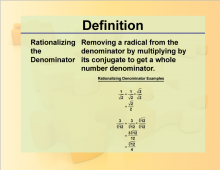
|
Definition--Rationals and Radicals--Rationalizing the Denominator | Rationalizing the DenominatorTopicRationals and Radicals DefinitionRationalizing the denominator is the process of eliminating radicals or complex numbers from the denominator of a fraction by multiplying both the numerator and denominator by an appropriate factor. DescriptionRationalizing the Denominator is a crucial technique in the study of Radical Numbers, Expressions, Equations, and Functions. This process involves removing radicals or complex numbers from the denominator of a fraction, which simplifies the expression and often makes it easier to evaluate or compare with other expressions. For example, to rationalize the denominator of |
Radical Expressions |

|
Definition--Rationals and Radicals--Conjugate of a Radical | Conjugate of a RadicalTopicRationals and Radicals DefinitionThe conjugate of a radical expression is obtained by changing the sign between two terms in a binomial. DescriptionIn the context of Radical Numbers, Expressions, Equations, and Functions, the concept of conjugates is essential for simplifying expressions. When dealing with radicals, particularly in the denominator, multiplying by the conjugate can help to rationalize the expression. This process eliminates the radical from the denominator, making the expression easier to work with. |
Radical Expressions |
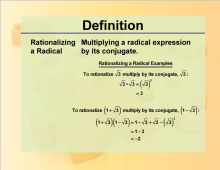
|
Definition--Rationals and Radicals--Rationalizing a Radical | Rationalizing a RadicalTopicRationals and Radicals DefinitionRationalizing a radical is the process of eliminating radicals from the denominator of a fraction by multiplying both the numerator and denominator by an appropriate factor. DescriptionRationalizing a Radical is an important technique in the study of Radical Numbers, Expressions, Equations, and Functions. This process involves eliminating radicals from the denominator of a fraction, which simplifies the expression and often makes it easier to work with or compare to other expressions. For example, to rationalize the denominator of 1√3 |
Radical Expressions |
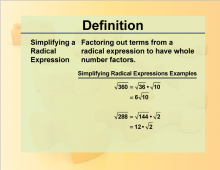
|
Definition--Rationals and Radicals--Simplifying a Radical Expression | Simplifying a Radical ExpressionTopicRationals and Radicals DefinitionSimplifying a radical expression involves reducing the expression to its simplest form by factoring the radicand and removing any perfect square factors (for square roots) or perfect cube factors (for cube roots). DescriptionSimplifying a Radical Expression is a fundamental skill in the study of Radical Numbers, Expressions, Equations, and Functions. This process involves reducing a radical expression to its simplest form, which often makes it easier to work with and understand. For example, simplifying √18 results in |
Radical Expressions |
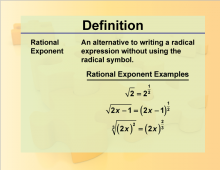
|
Definition--Rationals and Radicals--Rational Exponent | Rational ExponentTopicRationals and Radicals DefinitionA rational exponent is an exponent that is a fraction, where the numerator indicates the power and the denominator indicates the root. DescriptionRational Exponents are a crucial concept in the study of Rational Numbers, Expressions, Equations, and Functions. These exponents are fractions, where the numerator indicates the power and the denominator indicates the root. For example, the expression am/n can be rewritten as n√am |
Rational Expressions |

|
Definition--Rationals and Radicals--Laws of Rational Exponents | Laws of Rational ExponentsTopicRationals and Radicals DefinitionThe laws of rational exponents describe how to handle exponents that are fractions, including rules for multiplication, division, and raising a power to a power. DescriptionThe Laws of Rational Exponents are vital in the study of Rational Numbers, Expressions, Equations, and Functions. These laws provide a framework for simplifying expressions involving exponents that are fractions. For example, the law am/n=n√am |
Rational Expressions |
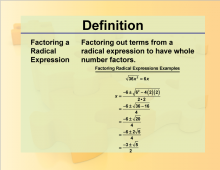
|
Definition--Rationals and Radicals--Factoring a Radical | Factoring a RadicalTopicRationals and Radicals DefinitionFactoring a radical involves expressing it as a product of simpler expressions. DescriptionFactoring radicals is a key technique in the study of Radical Numbers, Expressions, Equations, and Functions. It simplifies complex radical expressions, making them easier to work with. This process is essential for solving equations and for performing algebraic manipulations involving radicals. Understanding how to factor radicals is also important for simplifying expressions in calculus and higher-level mathematics. It helps in breaking down complex problems into more manageable parts. |
Radical Functions and Equations |
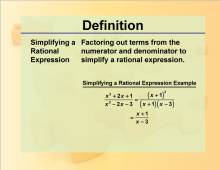
|
Definition--Rationals and Radicals--Simplifying a Rational Expression | Simplifying a Rational ExpressionTopicRationals and Radicals DefinitionSimplifying a rational expression involves reducing the fraction to its lowest terms by factoring both the numerator and denominator and canceling common factors. DescriptionSimplifying a Rational Expression is a crucial skill in the study of Rational Numbers, Expressions, Equations, and Functions. This process involves reducing a rational expression to its simplest form by factoring both the numerator and denominator and canceling common factors. For example, simplifying x2−1x−1 results in x + 1 for |
Rational Expressions |
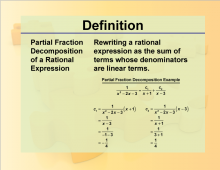
|
Definition--Rationals and Radicals--Partial Fraction Decomposition of a Rational Expression | Partial Fraction Decomposition of a Rational ExpressionTopicRationals and Radicals DefinitionPartial fraction decomposition is a method used to express a rational expression as a sum of simpler fractions. DescriptionPartial Fraction Decomposition is a powerful tool in the study of Rational Numbers, Expressions, Equations, and Functions. It involves breaking down a complex rational expression into a sum of simpler fractions, which are easier to integrate or differentiate. For example, the rational function 2x+3(x+1)(x−2) can be decomposed into |
Rational Expressions |
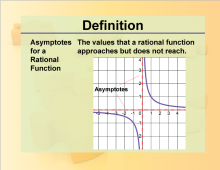
|
Definition--Rationals and Radicals--Asymptotes for a Rational Function | Asymptotes for a Rational FunctionTopicRationals and Radicals DefinitionAn asymptote is a line that a graph approaches but never touches. DescriptionAsymptotes are significant in the study of Rational Numbers, Expressions, Equations, and Functions. They help in understanding the behavior of graphs of rational functions, particularly as the values of the variables approach certain limits. Horizontal asymptotes indicate the value that the function approaches as the input grows infinitely large or small. Vertical asymptotes show the values that the function cannot take because they cause division by zero. |
Rational Functions and Equations |
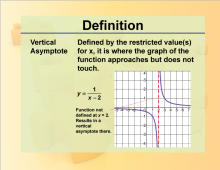
|
Definition--Rationals and Radicals--Vertical Asymptote | Vertical AsymptoteTopicRationals and Radicals DefinitionA vertical asymptote is a vertical line that the graph of a function approaches but never reaches as the input values get closer to a certain point. DescriptionVertical Asymptotes are a crucial concept in the study of Rational Numbers, Expressions, Equations, and Functions. They occur in rational functions when the denominator equals zero for certain input values, causing the function to approach infinity or negative infinity. For example, the function f(x)=1x−2 |
Rational Functions and Equations |

|
Definition--Rationals and Radicals--Horizontal Asymptote | Horizontal AsymptoteTopicRationals and Radicals DefinitionA horizontal asymptote is a horizontal line that a rational function graph approaches as the input values become very large or very small. DescriptionHorizontal asymptotes are an important concept in the study of Rational Numbers, Expressions, Equations, and Functions. They indicate the value that a function approaches as the input grows infinitely large or small. Understanding horizontal asymptotes is crucial for graphing rational functions accurately and for analyzing their long-term behavior. |
Rational Functions and Equations |
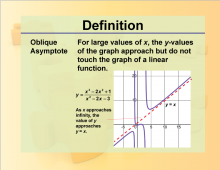
|
Definition--Rationals and Radicals--Oblique Asymptote | Oblique AsymptoteTopicRationals and Radicals DefinitionAn oblique asymptote is a diagonal line that the graph of a function approaches as the input values become very large or very small. DescriptionOblique Asymptotes are important in the study of Rational Numbers, Expressions, Equations, and Functions. They occur in rational functions where the degree of the numerator is one more than the degree of the denominator. For example, the function f(x)=x2+1x |
Rational Functions and Equations |

|
Definition--Rationals and Radicals--Rational Equations | Rational EquationsTopicRationals and Radicals DefinitionRational equations are equations that involve rational expressions, which are fractions containing polynomials in the numerator and denominator. DescriptionRational Equations are a fundamental aspect of Rational Numbers, Expressions, Equations, and Functions. These equations involve rational expressions, which are fractions containing polynomials in the numerator and denominator. Solving rational equations typically requires finding a common denominator, clearing the fractions, and then solving the resulting polynomial equation. For example, to solve 1x+1x+1=12 |
Rational Functions and Equations |

|
Definition--Rationals and Radicals--Radical Equations | Radical EquationsTopicRationals and Radicals DefinitionRadical equations are equations in which the variable is inside a radical, such as a square root or cube root. DescriptionRadical Equations are a fundamental aspect of Radical Numbers, Expressions, Equations, and Functions. These equations involve variables within radical signs, such as square roots or cube roots. Solving radical equations typically requires isolating the radical on one side of the equation and then squaring both sides to eliminate the radical. For example, to solve √x+3=5 one would square both sides to obtain x+3=25 |
Radical Functions and Equations |
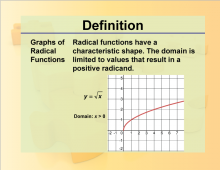
|
Definition--Rationals and Radicals--Graphs of Radical Functions | Graphs of Radical FunctionsTopicRationals and Radicals DefinitionGraphs of radical functions are visual representations of equations involving radicals. DescriptionGraphs of radical functions are crucial in the study of Radical Numbers, Expressions, Equations, and Functions. They provide a visual understanding of how these functions behave, including their domains, ranges, and key features such as intercepts and asymptotes. |
Radical Functions and Equations |
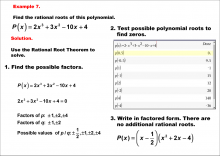
|
Math Example--Polynomial Concepts-- Rational Root Theorem: Example 7 | Math Example--Polynomial Concepts-- Rational Root Theorem: Example 7TopicPolynomials |
Factoring Polynomials |
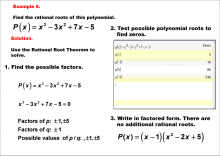
|
Math Example--Polynomial Concepts-- Rational Root Theorem: Example 6 | Math Example--Polynomial Concepts-- Rational Root Theorem: Example 6TopicPolynomials DescriptionThe example illustrates the process of finding rational roots for the polynomial. Find the rational roots of the polynomial P(x) = x3 - 3x2 + 7x - 5 using the Rational Root Theorem. 1. Identify factors of the constant term (-5), which are ±1 and ±5, and factors of the leading coefficient (1), which is ±1. 2. Form possible values of p/q: ±1 and ±5. 3. Test these values to find the roots. Roots found are x = 1. 4. The polynomial can be factored as P(x) = (x - 1)(x2 - 2x + 5). The answer is P(x) = (x - 1)(x2 - 2x + 5). There are no additional rational roots. |
Factoring Polynomials |

|
Math Example--Polynomial Concepts-- Rational Root Theorem: Example 5 | Math Example--Polynomial Concepts-- Rational Root Theorem: Example 5TopicPolynomials DescriptionThe example illustrates the process of finding rational roots for the polynomial. Find the rational roots of the polynomial P(x) = 3x3 - 7x2 + 4 using the Rational Root Theorem. 1. Identify factors of the constant term (4), which are ±1, ±2, and ±4, and factors of the leading coefficient (3), which are ±1 and ±3. 2. Form possible values of p/q: ±1/3, ±2/3, ±1, ±4/3, ±2, and ±4. 3. Test these values to find the roots. Roots found are x = -2/3, 1, and 2. 4. The polynomial can be factored as P(x) = 3x3 - 7x2 + 4. The answer is P(x)=(x + 2/3)(x - 1)(x - 2). |
Factoring Polynomials |
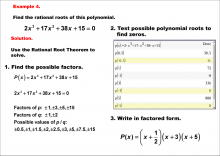
|
Math Example--Polynomial Concepts-- Rational Root Theorem: Example 4 | Math Example--Polynomial Concepts-- Rational Root Theorem: Example 4TopicPolynomials |
Factoring Polynomials |
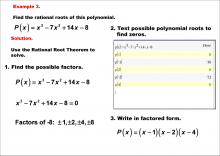
|
Math Example--Polynomial Concepts-- Rational Root Theorem: Example 3 | Math Example--Polynomial Concepts-- Rational Root Theorem: Example 3TopicPolynomials DescriptionThe example illustrates the process of finding rational roots for the polynomial. Find the rational roots of the polynomial P(x) = x3 - 7x2 + 14x - 8 using the Rational Root Theorem. 1. Identify possible factors of the constant term (-8), which are ±1, ±2, ±4, and ±8. 2. Test each factor by substituting them into the polynomial until a root is found. Roots found are x = 1, 2, and 4. 3. The polynomial can be factored as P(x)=(x - 1)(x - 2)(x - 4). The answer is P(x) = x3 - 7x2 + 14x - 8. |
Factoring Polynomials |
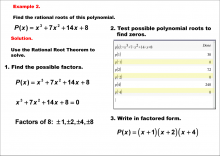
|
Math Example--Polynomial Concepts-- Rational Root Theorem: Example 2 | Math Example--Polynomial Concepts-- Rational Root Theorem: Example 2TopicPolynomials DescriptionThe example illustrates the process of finding rational roots for the polynomial. Find the rational roots of the polynomial P(x) = x3 + 7x2 + 14x + 8 using the Rational Root Theorem. 1. Identify possible factors of the constant term (8), which are ±1, ±2, ±4, and ±8. 2. Test each factor by substituting them into the polynomial to find the roots. Roots found are x = -1, -2, and -4. 3. The polynomial can be factored as P(x) = x3 + 7x2 + 14x + 8. The answer is P(x) = (x + 1)(x + 2)(x + 4). |
Factoring Polynomials |
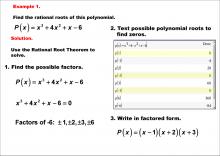
|
Math Example--Polynomial Concepts-- Rational Root Theorem: Example 1 | Math Example--Polynomial Concepts-- Rational Root Theorem: Example 1TopicPolynomials DescriptionThe example illustrates the process of finding rational roots for the polynomial. Find the rational roots of the polynomial P(x) = x3 + 4x2 + x - 6 using the Rational Root Theorem. 1. Identify possible factors of the constant term (-6), which are ±1, ±2, ±3, and ±6. 2. Test each factor as possible roots by substituting them into the polynomial until a root is found. Roots found are x = 1, -2, and -3. 3. The polynomial can be factored as P(x) = x3 + 4x2 + x - 6. The answer is P(x)=(x - 1)(x + 2)(x + 3). |
Factoring Polynomials |

|
Definition--Polynomial Concepts--Rational Root Theorem | Rational Root TheoremTopicPolynomials DefinitionThe Rational Root Theorem states that any rational root of a polynomial equation is a factor of the constant term divided by a factor of the leading coefficient. DescriptionThe Rational Root Theorem is a powerful tool in algebra that provides a systematic way to identify possible rational roots of a polynomial equation. According to the theorem, any rational root of a polynomial equation is a factor of the constant term divided by a factor of the leading coefficient. This theorem is particularly useful for solving higher-degree polynomial equations and for analyzing polynomial functions. |
Factoring Polynomials |

|
Video Tutorial: Ratios, Video 20 | Video Tutorial: Ratios and Rates: Rate of Change
This is part of a collection of video tutorials on the topic of Ratios and Proportions. This series includes a complete overview of ratios, equivalent ratios, rates, unit rates, and proportions. The following section will provide additional background information for the complete series of videos. What Are Ratios?A ratio is the relationship between two or more quantities among a group of items. The purpose of a ratio is find the relationship between two or more items in the collection. Let's look at an example. |
Point-Slope Form and Slope |